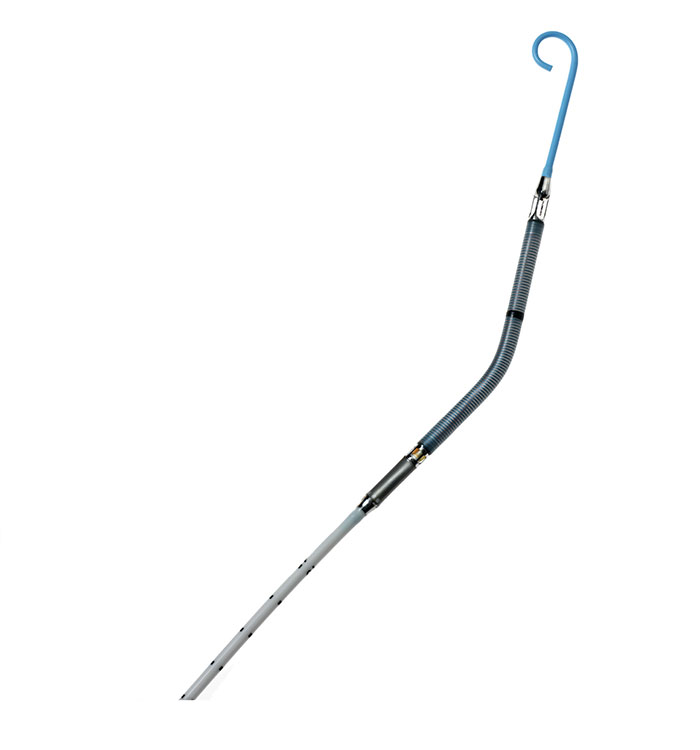University Hospitals Only Site in Ohio for Important Trial that May Prevent Significant Damage to Heart Muscle after Major Heart Attack
January 25, 2021
Innovative approach employs Impella® device prior to revascularization to prevent heart muscle damage
Innovations in Cardiovascular Medicine & Surgery | Winter 2021
 Paul Poommipanit, MD
Paul Poommipanit, MDUniversity Hospitals Harrington Heart & Vascular Institute is the only program in Ohio to offer a clinical trial aimed at improving outcomes for people who experience a heart attack in the left anterior descending artery (LAD) – notoriously known as the “widowmaker.”
 Caption: Impella device.
Caption: Impella device.The randomized, controlled STEMI DTU trial is evaluating whether unloading the left ventricle by using a pump (Impella® device) from the groin in patients with large heart attack would result in less myocardial injury. The trial compares this novel approach to standard of care for large myocardial infarctions – namely LAD STEMI patients. “The trial will take place at our flagship UH Cleveland Medical Center, and also at four UH community hospitals: UH Ahuja, UH Parma, UH Portage and UH Geauga medical centers,” says Mehdi Shishehbor, DO, MPH, PhD, President, UH Harrington Heart & Vascular Institute. “We are proud to continue to show our commitment to the communities here in Northeast Ohio by bringing cutting-edge technologies close to home.”
“Historically, patients who have heart attacks in what we call the ‘widowmaker’ artery or the left anterior descending artery, can have pretty sizeable infarcts that effect their left ventricular function and thus decrease their life expectancy,” says interventional cardiologist Paul Poommipanit, MD, interventional cardiologist, UH Harrington Heart & Vascular Institute, and Clinical Assistant Professor, Case Western Reserve University School of Medicine, who is leading the new trial at University Hospitals. “It is thought that if we could somehow support the heart, we could decrease the infarct size, improve left ventricular function and ideally improve how long they live. There is animal data that suggests that if you support the heart before you open up the artery, you can help the heart to remodel. And then you open up the artery, the infarct size is less, and thus the left ventricular function is better. Now, there are a couple of jumps to get there, but that's the theory.”
A pilot study in 2019 showed that this approach is workable in LAD STEMI patients, Dr. Poommipanit says.
“The pilot study actually demonstrated that this is feasible, meaning that there's no harm to the patient doing it,” he says. “They didn't have big enough numbers to suggest whether or not there is a decrease in infarct size or mortality benefit, but at least preliminarily, it looks like that's the case as well. So now we’re at the next step: a randomized trial where you either treat patients the way we normally do, which is rush as quickly as possible, open up the artery, put a stent in and see how they do versus putting the pump in, waiting 30-60 minutes, opening up the artery, then keeping the pump in for a few hours after the case, and then pulling the pump out.”
Amassing the data necessary to evaluate this new approach to treating LAD STEMI will be quite labor-intensive, Dr. Poommipanit says. While a typical start-to-finish treatment window for one of these heart attacks with standard treatment is two and a half to three hours, this new approach takes considerably more time and effort.
“We're talking about essentially putting a pump in, which takes some effort to get in, waiting for literally 30 minutes while you think about opening up this artery, then opening it up, then leaving the pump in for up to six hours and then coming back to the cath lab and pulling it out,” he says. “Committing to complex clinical trials can be challenging; however, given the impact this clinical trial may have on patients, we decided to proceed here at University Hospitals,” Dr. Shishehbor says. “We are proud of our research and clinical team for bringing this novel technology and approach to UH and Northeast Ohio.”
It will be years before interventional cardiologists know whether this new approach to LAD STEMI patients is superior to the current standard of care. However, Dr. Poommipanit is cautiously optimistic that it will make a measurable difference.
“What all the preclinical data suggests is that doing it this way will decrease your infarct size and thus improve longevity,” he says. “That is what we hope.”


